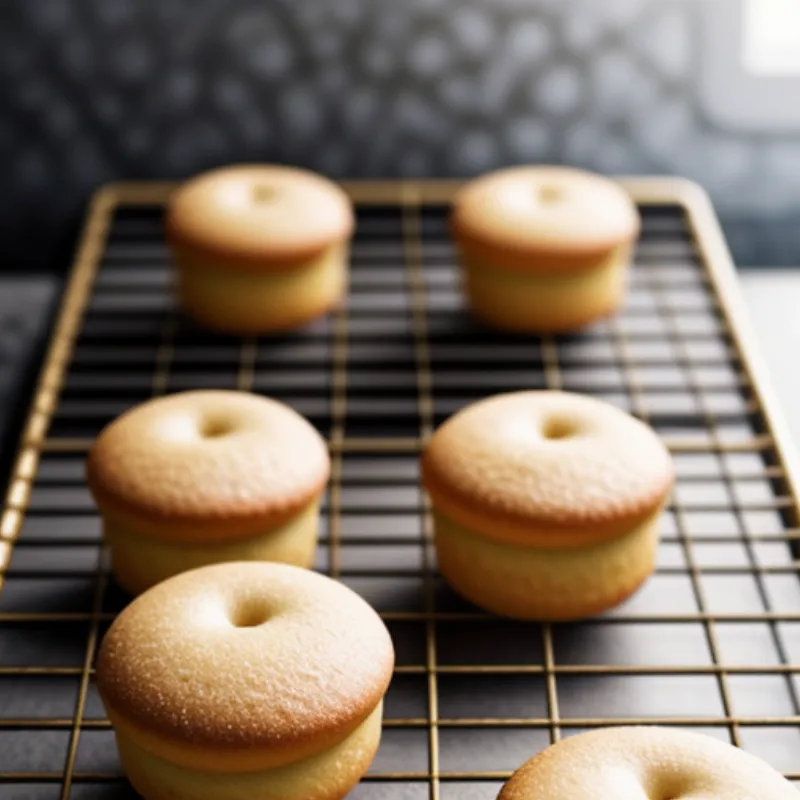Madeleine cakes – those petite, shell-shaped cookies with a distinctive hump on their back – are a true testament to the fact that good things come in small packages. Originating from the Lorraine region of France, these little cakes have charmed taste buds for centuries with their delicate texture and subtle, buttery flavor.
What makes Madeleines truly special is their ability to transport you back to childhood with every bite. The aroma of butter and vanilla wafting from the oven, the satisfying crunch as you break through the crisp exterior to reveal the soft, airy interior… it’s a sensory experience that evokes pure joy.
Whether you’re a baking enthusiast looking for a new challenge or simply craving a taste of France in your own kitchen, this recipe will guide you through each step, ensuring perfect Madeleines every time. So, tie on your apron and get ready to discover the magic of these charming little cakes!
Gathering Your Ingredients
Before we embark on our baking journey, let’s gather our ingredients. This recipe is for a classic vanilla Madeleine, but feel free to get creative with flavorings later on!
- 1 cup (2 sticks) unsalted butter, melted and cooled slightly, plus extra for greasing the pan
- 1 ½ cups all-purpose flour, plus extra for dusting
- 1 teaspoon baking powder
- ¼ teaspoon salt
- ¾ cup granulated sugar
- 2 large eggs, at room temperature
- 2 teaspoons pure vanilla extract
- Zest of one lemon (optional, for a citrusy twist)
Essential Tools
- Madeleine pan – This special pan is key to achieving the iconic shell shape.
- Two mixing bowls – One for dry ingredients and one for wet ingredients.
- Whisk – For combining dry ingredients and beating the eggs.
- Rubber spatula – For gently incorporating the ingredients and scraping the bowl.
- Measuring cups and spoons – For accurate measurements, essential for consistent results.
Let’s Bake!
Step 1: Preparing the Batter
- In a medium bowl, whisk together the flour, baking powder, and salt. This ensures that the leavening agents are evenly distributed.
- In a separate large bowl, whisk together the granulated sugar and eggs until the mixture is pale and slightly thickened. This step adds air to the batter, resulting in lighter Madeleines.
- Gradually drizzle in the melted and cooled butter while whisking constantly. Make sure the butter is not hot, as it could cook the eggs.
- Stir in the vanilla extract and lemon zest (if using).
- Gently fold the dry ingredients into the wet ingredients, mixing until just combined. Avoid overmixing, as it can lead to tough Madeleines.
Step 2: Chilling the Batter
- Cover the bowl with plastic wrap and refrigerate for at least 1 hour, or up to overnight. This crucial step allows the gluten in the flour to relax, resulting in a more tender texture. It also allows the flavors to meld beautifully.
Step 3: Baking the Madeleines
- Preheat your oven to 375°F (190°C).
- Generously grease the Madeleine pan with butter and dust lightly with flour, tapping out any excess. This prevents the cakes from sticking and ensures easy release.
- Fill each mold in the Madeleine pan almost to the top with batter.
- Bake for 10-12 minutes, or until the edges of the Madeleines are golden brown and the centers spring back when lightly pressed.
Step 4: Cooling & Serving
- Let the Madeleines cool in the pan for a few minutes before transferring them to a wire rack to cool completely.
 Madeleine Cakes Cooling on a Rack
Madeleine Cakes Cooling on a Rack
Tips for Perfect Madeleines
- Room Temperature Ingredients: Using room-temperature eggs and slightly cooled melted butter ensures that the ingredients emulsify properly, resulting in a smoother batter.
- Don’t Overmix: Overmixing develops the gluten in the flour, leading to dense, chewy Madeleines instead of light and airy ones.
- Chilling Time is Crucial: Chilling the batter allows the gluten to relax and the flavors to meld, resulting in more flavorful and tender Madeleines.
- Get to Know Your Oven: Oven temperatures can vary, so it’s essential to keep an eye on your Madeleines and adjust the baking time as needed.
FAQs About Making Madeleines
Q: Can I use a different type of pan if I don’t have a Madeleine pan?
A: While a Madeleine pan is ideal for achieving the signature shell shape, you can use a mini muffin pan as a substitute. Keep in mind that the baking time may vary slightly.
Q: My Madeleines didn’t develop a prominent hump. What went wrong?
A: The iconic hump is a result of the batter being chilled properly and the oven temperature being hot enough. Make sure to chill your batter for at least an hour and ensure your oven is preheated thoroughly.
Q: Can I add other flavors to my Madeleines?
A: Absolutely! Madeleines are incredibly versatile. You can add a teaspoon of citrus zest, a pinch of ground spices like cardamom or nutmeg, or even a tablespoon of cocoa powder to the batter for a chocolate twist.
Enjoy!
 Enjoying Madeleine Cakes
Enjoying Madeleine Cakes
There you have it! Now you can recreate the magic of these delightful French cookies in your own kitchen. Serve them with a dusting of powdered sugar alongside a cup of tea or coffee for a truly delightful experience. Don’t forget to share your baking triumphs with us in the comments below! Happy baking!
